Our Rating
4.9
(out of 5)
Pros
- Pristine high end
- Musically responsive
- Same components as the famous U87 at one-third the price
- Low self-noise
- Huge dynamic range
Cons
- no shockmount included
Pick-up Pattern: Cardioid
Pads and Filters: None
Weight: 450 g
Max SPL: 138 dB
Self-noise: 7 dB
Neumann TLM 103 Microphone
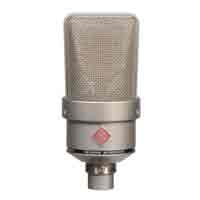
Bottom Line
A chunky wedge-shaped version of the famous U87 microphone at one-third the cost.
Check Availability and Price in Your Region:
US and Canada
UK and Europe
Introducing the TLM 103
The sonic signature of your large-diaphragm condenser mic will define your sound, making it arguably the biggest piece in the puzzle of any set-up. But everyone looking for a sound upgrade will have budget constraints.
The obvious, most reliable upgrade choice to many is the Neumann U87. The U87 is the famous gold-standard, musically responsive, large-diaphragm condenser mic used in countless recordings on a wide array of sound sources. Most large professional studios will have a few U87s at hand.
The problem is that a U87 costs around $3700. Enter the Neumann TLM 103. It is a repackaged U87 at less than one-third the cost, with a smaller body and a fixed cardioid polar pattern.
But does it really deliver? We take nothing for granted here, so we put it through its paces in our microphone test drive.
What’s in the box?
The mic comes in satin nickel (shown here) or matte black. You can see the unboxing here in this video.
The TLM 103 arrived in a wooden carry case with a standard swivel mount (SG1 mount) and thread adapter for connecting to different mic stands. To reduce costs, Neumann has not provided a cable, shockmount, or pop filter.
Of course, Neumann suggests that you pair this with their custom EA1 or EA4 shockmount, both of which are prohibitively expensive. We suggest using a universal shockmount or a generic shockmount compatible TLM 103. In our opinion, these work just as well at reducing rumble.
Who is this mic for?
Home recordists, professional broadcasters, and professional studios looking to upgrade to a high-end, reliable, versatile studio condenser mic.
Who is this mic NOT for?
This mic is not suited for the following applications:
- live set-ups
- noisy, untreated rooms
- situations that require polar patterns other than Cardioid
Alternatives to the TLM 103
Neumann U87 ai
The Gold standard for large-condenser studio mics. A classic that will outlive you and your children.
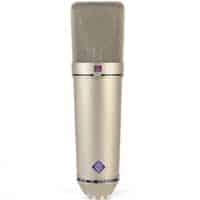
Neumann TLM 102
The most affordable Neumann condenser mic. Smaller than the 103, with a slightly different sound.
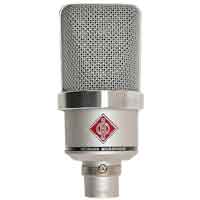
Mojave MA-200
A lovely tube mic with a warm, full-bodied response that uses the same capsule as the TLM 103 (K67).
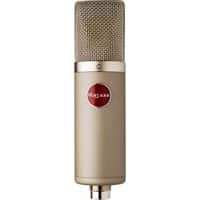
Check out our gear category page for more on microphones and audio gear.
Build / Design
The Neumann TLM 103 is essentially half of a U87.
The TLM 103 uses a K67-style capsule, just like the U87. The U87 has switchable polar patterns so its K87 capsule has double the parts to capture sound from both sides. The TLM 103 uses half the parts to form a fixed cardioid, transformerless mic.
The first step toward a more affordable U87 was to ditch the transformer. Neumann’s prefix ‘TLM’ stands for ‘Transformer-Less Microphone’. Transformers add their own sonic color, sometimes limit the transient response of a mic, and tend to be expensive.
The chunky wedge shape makes it more versatile in the studio and less mic-saggy than the traditional long cylinder shape.
Self-noise and Max SPL
This mic has very low self-noise for intimate recording and can also handle rocking loud.
In fact, the TLM 103 outperforms the famous U87 with lower self-noise and a higher max SPL. The TLM 103 measures at 7 dB for self-noise while the U87 is 12dB. In our mic tests, that is a noticeable difference.
And dynamically, the TLM 103 can handle a max SPL of 135 dB while the U87 is recorded at 117 dB. The ability to handle the loud means that the mic doesn’t require a pre-attenuator switch.
Neumann has made all of these adjustments to the old U87 capsule in order to reduce the cost and size and produce a more affordable and versatile microphone.
Sound
Neumann TLM 103 Frequency Response chart
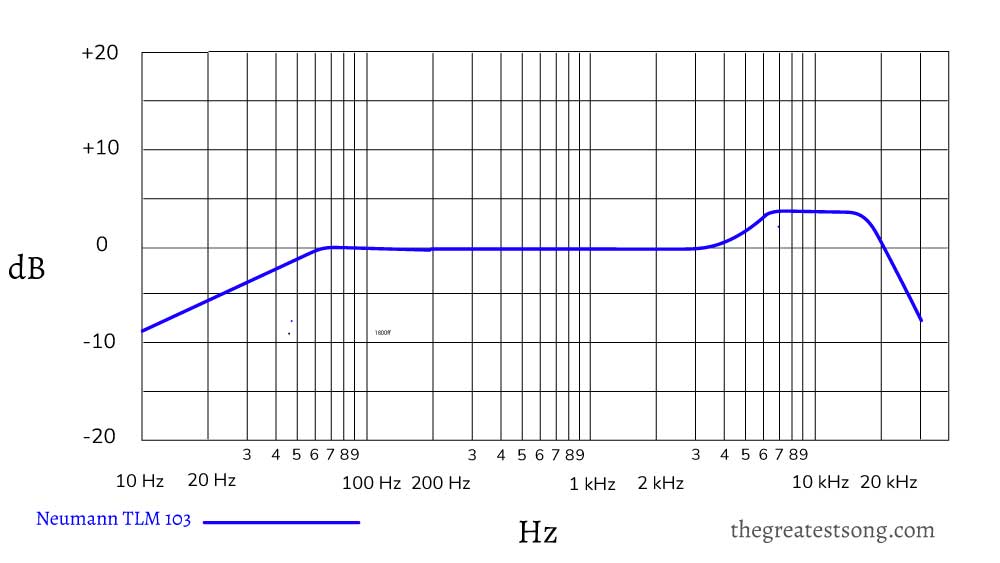
As you can see in the frequency response chart above, the TLM 103 has a flat response with a gentle presence boost around 5 – 15 kHz. This frequency response is nearly identical to that of the U87. (compared below)
Neumann TLM 103 vs U87 Frequency response Chart
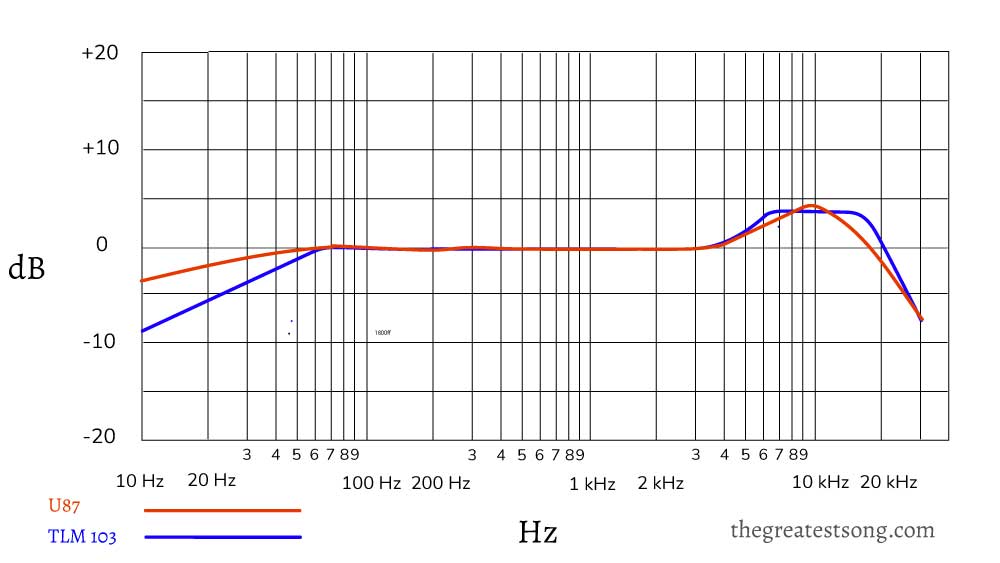
Neumann TLM 103 Test Drive
We used a Universal Audio Apollo Solo Interface recorded with Logic Pro X. There is no EQ or compression or other enhancements applied to any of the audio clips here. We adjusted the gain from the audio interface to taste. The guitars were a Martin steel-string acoustic guitar and Fender Strat plugged into 40 Watt Fender Champ.
Full disclosure: We fully acknowledge that there is no one way to use a microphone. Mic placement, how you play or sing, not to mention EQ, compression, Impedance, and pre-amp settings can all have dramatic effects on the final result.
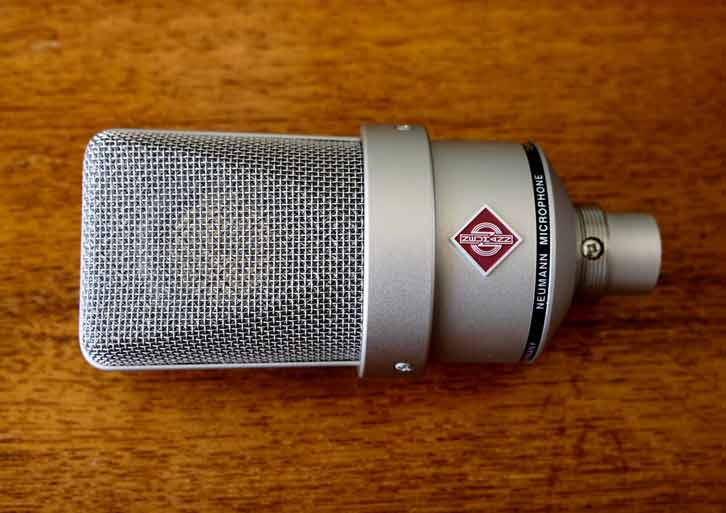
Sung Vocals with acoustic guitar Test
The super-clean high-end that the TLM 103 gives to the vocals here is what ultimately wins me over on this mic. Somehow, the detail is more detailed, but in a flattering way.
This was recorded with the mic at lip-level with the acoustic guitar on my lap.
Spoken Vocals Test – Sibilance, plosives, off-axis coloration Test
As you can hear in the spoken test below, there were no problems with plosives or sibilance. There is also very little noticeable off-axis coloration of the sound. In other words, when you’re not speaking directly into the mic there’s no distortion of the sound.
Rear and side rejection of sound was about normal for a condenser mic. It picks up the room you are in.
The proximity effect on the TLM 103 (increased bass frequencies as you get closer to the mic) was very noticeable.
Acoustic guitar tests
The TLM 103 on acoustic guitar was very satisfying. For fingerpicking styles, its low self-noise allows you to use a lot of gain from your pre-amp and achieve a high-detail intimate sound.
For roots style strumming, I would imagine this ideally paired with a ‘character’ mic like an SM57. The TLM 103 would get all the brilliance and detail and the character mic would give you some grit.
Electric Guitar (Clean) Test
Conclusions about the Sound
Mics are not really better than other mics, they just sound different. As you approach the high-end microphones, you are paying for consistency, a very particular quality and timbre, and musical response.
The Neumann U87 (full review) is famous for its ability to produce the desired sound with very few adjustments. In my opinion, the TLM delivers ready-to-go sound nearly as well as the U87.
The TLM 103 delivered a musical response to everything we threw at it. There seems to be no need for attenuation pads, as it handled loud and soft with aplomb.
The pristine high-end was more impressive than I expected. (see sung vocals with acoustic guitar test above) It was never harsh and balanced smoothly with its considerable low end.
The U87 has delivers fantastic, authentic, versatile results, but the TLM 103 is not far behind. And, it outperforms the TLM 102 in its refined top end and musical response.
What they say about the Neumann TLM 103
We asked around the biz and got a few words from some pros who use this mic:
We use it [TLM 103] to record nearly everything. I love it on voices, guitars, piano, drums… what else would I want?
Steve Bolmann, Sound Engineer
We have a Neumann U87 and a TLM 103 in our studio. Recording guitars, voices, and drums, I cannot tell the difference between these mics.
Michael Watson, Sound Engineer
Frequently Asked Questions
How does this compare with the Neumann TLM 102?
The TLM 103 was designed as a cheaper, smaller, quieter U87. The TLM 102 is designed as a versatile condenser for any studio. The TLM 103, to my ears, has a more sensitive musical response and even more flattering detail on the high end.
For more information see our comparison post Neumann TLM 102 vs 103.
Does the TLM 103 really sound like a U87?
Short answer: yes, the sound signature is similar.
That said, it is not exactly the same. Like all things with microphones, we’re talking about subtleties. I found the results of the U87 to be a little more transparent and a just a bit more ready-to-go than those from the TLM 103.
U87s, especially those that have lived a bit, all have their own unique subtleties.
Questions or Comments?
Join the discussion here on Facebook.
Neumann TLM 103 Microphone

Check Availability and Price in Your Region:
US and Canada
UK and Europe